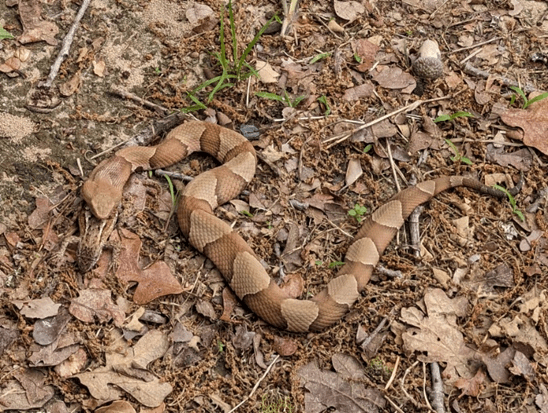by Joyce Conner and Donna Lewis
If you have been paying attention lately in your garden or yard, you probably will have noticed that our friends, the snakes are back.
They are out grocery shopping for lizards, frogs, birds, eggs, and other small mammals. Humans are NOT on the list, but they will bite us if we scare them or step on them. Can you blame them?
So, when you move leaves around or pull weeds, you need to be observant.
Sticking your hand down into the brush might not be so smart. (Wasps might not like us to disturb them either, so beware of their bites and stings too!)
Texas Rat Snakes, Broad-Banded Copperheads, and Western Cottonmouths are the main ones out on our properties, so you probably have them too.
There are many more Texas Snakes in Central Texas, but these are the recently observed species.
Most people are really afraid of snakes. But, they serve a purpose in nature as all wild things do. As they go about their business of finding food, reproducing, protecting themselves from their enemies, and maintaining a comfortable body temperature, they are no different from any of the other wild animals on this planet. And, as a member contributing to the cycle of life on earth, they play an important role in maintaining balance. Without snakes, we would have an overabundance of insects, rodents, amphibians, etc.
Almost all snakes are docile and will not bite unless provoked. We just have to remember that “provoking” them may be no more than walking/reaching too near where they are lying in wait for a lizard to come by.
Yes, the snakes are definitely out of their dens and enjoying the change in weather!
On Wednesday, April 24, Joyce and Mike dealt with two snakes that same day. First, a rat snake was found in the chicken coop.
Here Joyce is taking the Texas Rat Snake out of a nesting box. Notice the black blotchy purplish pattern on its back in the second picture. Rat snakes are not venomous but can bite. Use caution when handling them.

According to Texas Snakes: A Field Guide by James R. Dixon and John E. Werler, the Texas Rat Snake is one of Texas’ longest snakes. Most adults measure between 42 and 72 inches. It is found in brushy and wooden areas and can easily climb trees. After checking out its length, Joyce put it in a bucket and released it at one of the ponds away from the house.

Later that same day, Mike nearly stepped on a copperhead just off the porch. According to Texas Snakes, the Broad-Banded Copperhead “is marked with wide, reddish brown crossbands that alternate with narrower tan to pale brown interspaces.” The adult grows to usually 30 inches long.
This one appeared to be young (they can live up to 18 years) and short (we estimated around 2 feet). It blended in nicely with the dead leaves and dirt. While Joyce photographed, it stayed completely still. Until she reviewed her first photos, she didn’t notice that it had stunned a lizard.

Each time the copperhead was checked, the lizard was a little less visible, as it was being swallowed whole.

After a while, the lizard had completely disappeared inside the snake.

Mike and Joyce do not handle venomous snakes and do not recommend anyone doing so unless well trained and outfitted with special snake-catching equipment.
When checked later, the copperhead was no longer found around the porch.
However, the next day, Mike and grandson Bryce saw a long rat snake in another area of the yard. Joyce wonders whether it could be the same snake she took away from the house the day before. Snakes can find their way back to an area by smell. Since Joyce is the snake wrangler at the preserve and she wasn’t around, the boys were unable to catch and release it that day. But no worry – if it goes into the chicken coop, Joyce will catch and release it elsewhere!

